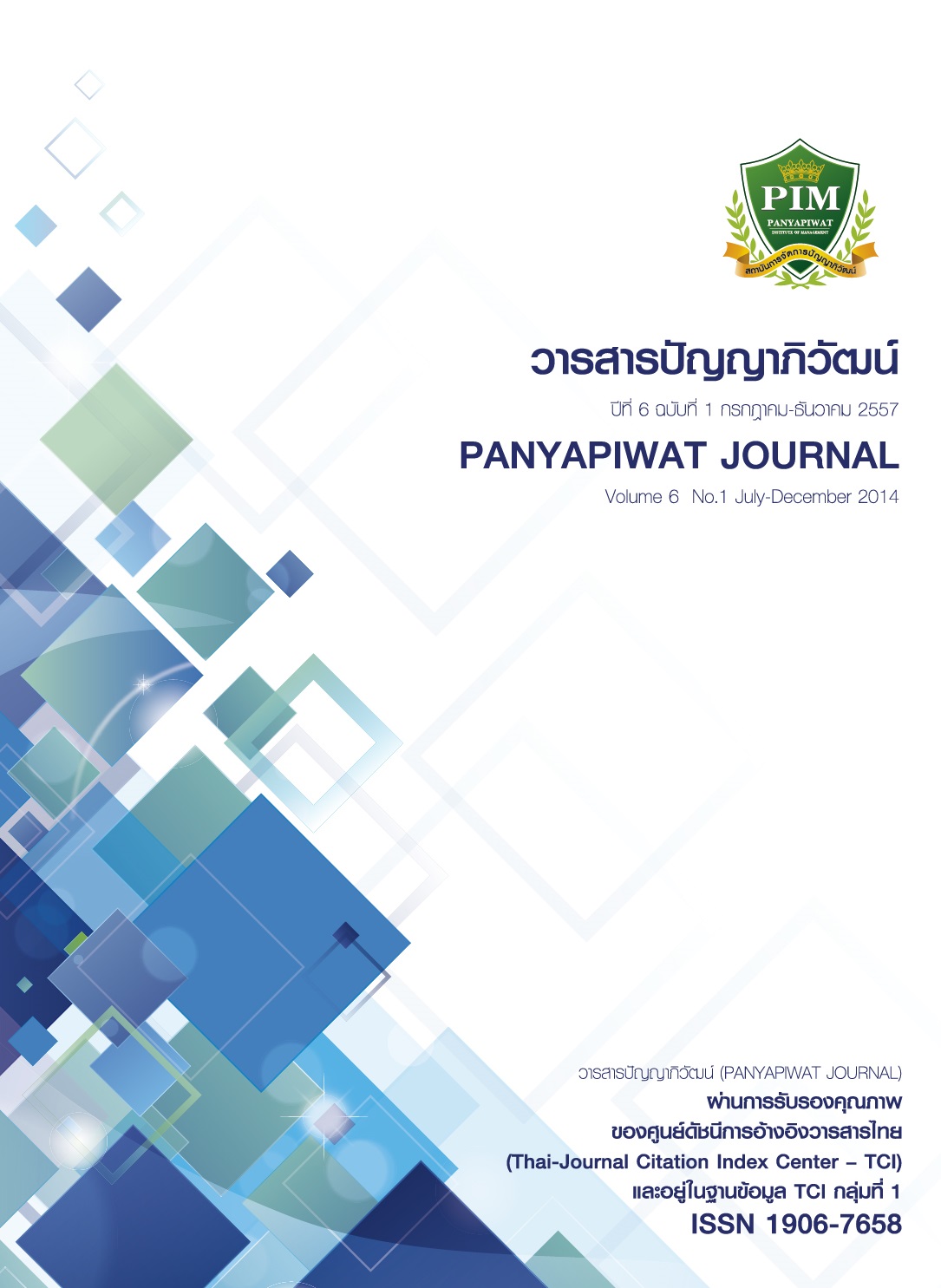ความสัมพันธ์ระหว่างการรับรู้ความยุติธรรมขององค์การ กับพฤติกรรมการทำงานที่เบี่ยงเบน: กรณีศึกษาบุคลากร สายสนับสนุนของมหาวิทยาลัยของรัฐแห่งหนึ่ง
Main Article Content
บทคัดย่อ
บทคัดย่อ
การศึกษานี้มีวัตถุประสงค์เพื่อศึกษา 1) ระดับการรับรู้ความยุติธรรมขององค์การ และระดับการแสดงออกของพฤติกรรมการทำงานที่เบี่ยงเบนของบุคลากรสายสนับสนุนของมหาวิทยาลัยของรัฐแห่งหนึ่ง และ 2) ความสัมพันธ์ระหว่างการรับรู้ความยุติธรรมขององค์การและพฤติกรรมการทำงานที่เบี่ยงเบนของบุคลากรสายสนับสนุน โดยใช้แบบสอบถามเก็บข้อมูลจากบุคลากรสายสนับสนุนของมหาวิทยาลัยของรัฐแห่งหนึ่ง จำนวน 71 คน ผลการศึกษาพบว่า การรับรู้ความยุติธรรมองค์การด้านความยุติธรรมระหว่างบุคคล และด้านสารสนเทศอยู่ในระดับมาก ในขณะที่ด้านการแบ่งสรรปันส่วนและด้านกระบวนการอยู่ในระดับปานกลาง ในส่วนระดับพฤติกรรมการทำงานที่เบี่ยงเบน
พบว่า พฤติกรรมการทำงานที่เบี่ยงเบนด้านการเมืองอยู่ในระดับน้อย ส่วนพฤติกรรมการทำงานที่เบี่ยงเบนด้านการทำงานด้านทรัพย์สิน และความก้าวร้าวต่อบุคคล อยู่ในระดับน้อยมาก นอกจากนี้ ผลการทบสอบสมมติฐาน พบว่า ความยุติธรรมต่อการแบ่งสรรปันส่วนกับพฤติกรรมการทำงานที่เบี่ยงเบนด้านการเมือง มีความสัมพันธ์กันในทางลบ (r = -.254)อย่างมีนัยสำคัญทางสถิติที่ระดับ .05 และพบความสัมพันธ์ระหว่างความยุติธรรมต่อการแบ่งสรรปันส่วนกับพฤติกรรมการทำงานที่เบี่ยงเบนด้านความก้าวร้าวของบุคคล (r = .328) ที่ระดับนัยสำคัญทางสถิติที่ .01 นอกจากนี้ยังพบความสัมพันธ์ทางลบระหว่างความยุติธรรมต่อกระบวนการกับพฤติกรรมการทำงานที่เบี่ยงเบนด้านการเมือง (r = -.254)และพบความสัมพันธ์ระหว่างความยุติธรรมต่อกระบวนการกับพฤติกรรมการทำงานที่เบี่ยงเบนด้านความก้าวร้าว(r = .286) ที่ระดับนัยสำคัญทางสถิติที่ .05 ผลการวิเคราะห์การถดถอยพหุแบบขั้นตอน (Stepwise multipleregression analysis) พบว่า ความยุติธรรมต่อการแบ่งสรรปันส่วนเป็นปัจจัยที่มีความสัมพันธ์กับพฤติกรรมการทำงานที่เบี่ยงเบนทางด้านการเมืองและพฤติกรรมการทำงานที่เบี่ยงเบนทางด้านความก้าวร้าวของบุคคล อย่างมีนัยสำคัญทางสถิติที่ระดับ .05
Abstract
The objectives of this study were: 1) to study the levels of perceived organizational justice and workplace deviant behavior of non-academic staffs at a selected public university; and 2) to examine relationship between organizational justice perception and workplace deviant behavior of non-academic staffs at a selected public university. Data were collected from 71 non-academic staffs of a selected public university by using a self-administered questionnaire. The findings indicated that interpersonal and informational justices were perceived at a high level whereas
distributive and procedural justices were at a medium level. For workplace deviant behavior, this study found that political deviance was demonstrated at a low level whereas the rest of deviantbehaviors were demonstrated at a lowest level. To test hypothesis, the results showed the negative relationship between distributive justice and political deviance at the 0.05 level of significance. Also, the relationship between distributive justice and personal aggression was positively significant at 0.01 level. Results also demonstrated the negative relationship between procedural justice and political deviance, and the positive relationship between procedural justice
and personal aggression at 0.05 level. Additionally, stepwise multiple regression analysis also showed the correlation between distributive justice and political deviance, and the correlation between distributive justice and personal aggression at the significant level of 0.05.
Article Details
“ข้าพเจ้าและผู้เขียนร่วม (ถ้ามี) ขอรับรองว่า บทความที่เสนอมานี้ยังไม่เคยได้รับการตีพิมพ์และไม่ได้อยู่ระหว่างกระบวนการพิจารณาลงตีพิมพ์ในวารสารหรือแหล่งเผยแพร่อื่นใด ข้าพเจ้าและผู้เขียนร่วมยอมรับหลักเกณฑ์การพิจารณาต้นฉบับ ทั้งยินยอมให้กองบรรณาธิการมีสิทธิ์พิจารณาและตรวจแก้ต้นฉบับได้ตามที่เห็นสมควร พร้อมนี้ขอมอบลิขสิทธิ์บทความที่ได้รับการตีพิมพ์ให้แก่สถาบันการจัดการปัญญาภิวัฒน์หากมีการฟ้องร้องเรื่องการละเมิดลิขสิทธิ์เกี่ยวกับภาพ กราฟ ข้อความส่วนใดส่วนหนึ่งและ/หรือข้อคิดเห็นที่ปรากฏในบทความข้าพเจ้าและผู้เขียนร่วมยินยอมรับผิดชอบแต่เพียงฝ่ายเดียว”
เอกสารอ้างอิง
กัลยา วานิชย์บัญชา. (2553). สถิติสําหรับงานวิจัย. พิมพ์ครั้งที่ 5. กรุงเทพมหานคร: ธรรมสาร.
ชูชัย สมิทธิไกร. (2551). ลักษณะบุคลิกภาพที่พยากรณ์พฤติกรรมต่อต้านการปฏิบัติงาน. วารสารสงขลานครินทร์ฉบับสังคมศาสตร์และมนุษยศาสตร์, 14 (4), 513-530.
บุญธรรม กิจปรีดาบริสุทธิ์ (2549). สถิติวิเคราะห์เพื่อการวิจัย. พิมพ์ครั้งที่ 4. กรุงเทพมหานคร: จามจุรีโปรดักท์.
ประคอง กรรณสูตร. (2542). สถิติเพื่อการวิจัยทางพฤติกรรมศาสตร์. กรุงเทพมหานคร: จุฬาลงกรณ์มหาวิทยาลัย.
ศิริชัย กาญจนวาสี. (2554). การวิเคราะห์พหุระดับ. พิมพ์ครั้งที่ 5. กรุงเทพมหานคร: จุฬาลงกรณ์มหาวิทยาลัย.
Anwar, M.N., Sarwar, M., Awan, R.N., & Arif, M.I. (2011). Gender differences in workplace deviant behaviour of university teachers and modification techniques. International Education Studies, 4(1), 193-197.
Appelbaum, S. H., Deguire, K. J., & Lay, M. (2005). The relationship of ethical climate to deviant workplace behavior. Corporate Governance, 5(4), 43-56.
Appelbaum, S. H., Iaconi, G. D., & Matousek, A. (2007). Positive and negative deviant workplace behaviors: causes, impacts, and solutions. Corporate Governance, 7(5), 586-598.
Browning, V. (2008). An exploratory study into deviant behaviour in the service encounter: how and why front-line employees engage in deviant behavior. Journal of Management & Organizational, 14(4).
Chirasha, V. & Mahapa, M. (2012). An analysis of the causes and impact of deviant behavior in the workplace. The case of Secretaries in State Universities. Journal of Emerging, tends in Economics and Management Sciences, 3(5), 415-421.
Everton, W. J., Jolton, J. A., & Mastrangelo, P. M. (2007). Be nice and fair or else: understanding reasons for employees’ deviant behaviors. The Journal of Management Development, 26(2), 117-131.
Fagbohungbe, B. O., Akinbode, G. A. & Ayodeji, F. (2012). Organizational determinants of workplace deviant behaviours: an empirical analysis in Nigeria. International Journal of Business and Management, 7(5), 207-221.
Gill, H., Meyer, J. P., Lee, K., Shin, K., & Yoon, C. (2011). Affective and continuance commitment and their relations with deviant workplace behaviors in Korea. Asia Pacific Journal of Management, 28, 595-607.
Holtz, B. C. (2014). Interpersonal justice and deviance: the moderating effects of interpersonal justice values and justice orientation, Journal of Management. Retrieved May 15, 2014, from http://www.camden.rutgers.edu/pdf/holtz.pdf
Jambldorj, O. (2011). Investing the mediating effect of organizational justice on the relationship Guan-XI and workplace deviance behavior. Unpublished Master of Business Administration, Ming Chuan University.
Lau, V. C. S., Au, W. T. & Ho, J. M. C. (2003). A qualitative and quantitative review of antecedents of counterproductive behavior in organizations. Journal of Business and Psychology, 18(1).
Mccardle, J. G. (2007). Organizational justice and workplace deviance: the role of organizational structure, powerlessness, and information salience. Unpublished Doctoral Dissertation, University of Central Florida. Retrieved May 15, 2014 from, http://etd.fcla.edu/CF/CFE0001975/McCardle_Jie_G_200712_PhD.pdf
Moorhead, G. & Griffin, R. W. (2012). Managing organizational behavior. 10thed. South-Western, Cengage Learning: International Edition.
Peterson, D. K. (2002). Deviant workplace behavior and the organization’s ethical climate. Journal of Business and Psychology, 17(1), 47-61.
Robinson, S. L. & Bennett, R. J. (1995). A typology of deviant workplace behaviors: a multidimensional scaling study. Academy of Management Journal, 38(2), 555-572.
Robbin, S. & Judge, T. A. (2007). Organizational Behavior. 12thed.New Jersey: Pearson Education, Inc.
Syaebani, M. I. & Sobri, R. R. (2011). Relationship between organizational justice perception and engagement in deviant workplace behavior. The South East Asian Journal of Management, V(1), 37-49.
Vardi, Y. & Wiener, Y. (1996). Misbehavior in organization: motivational framework. Organization Science, 7(2), 151-165.
Vardi, Y. & Weitz, Y. (2004). Misbehavior in organization: theory, research, and management.New Jersey: Lawrence Erlbaum Associates, Inc.


